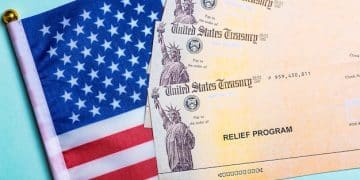Maximize Your Savings: Earn Passive Income with High-Yield Accounts in 2025

Maximize your savings in 2025 by leveraging high-yield savings accounts (HYSAs) to generate passive income, offering competitive interest rates and easy access to your funds.
Looking to maximize your savings: how to earn passive income with high-yield savings accounts in 2025? With the financial landscape constantly evolving, high-yield savings accounts (HYSAs) are emerging as a smart way to grow your money effortlessly. They offer higher interest rates than traditional savings accounts and are a safe, liquid way to earn passive income.
Understanding High-Yield Savings Accounts
High-yield savings accounts (HYSAs) have become increasingly popular as investors look for secure spots to park their cash. Let’s delve into what they are and how they can significantly enhance your savings.
What is a High-Yield Savings Account?
A high-yield savings account is a type of savings account that offers a higher interest rate compared to traditional savings accounts. These accounts are offered by banks and credit unions, often online-only, to attract more deposits.
How Do They Differ from Traditional Savings Accounts?
The key difference lies in the interest rate. Traditional savings accounts usually offer very low interest rates, often close to 0.01%, while HYSAs can offer rates much higher, sometimes over 4% or even 5%, depending on the economic climate and the financial institution.
- Higher Interest Rates: Offers significantly better returns than traditional accounts.
- FDIC Insurance: Typically insured by the FDIC up to $250,000 per depositor, per insured bank.
- Liquidity: Provides easy access to your funds when you need them.

By choosing a high-yield savings account, you ensure your money is working harder for you, growing at a faster pace. This can make a considerable difference over time, especially when compounded.
Benefits of Earning Passive Income with HYSAs
Earning passive income with high-yield savings accounts has several notable benefits that make them an attractive option for savers.
Increased Savings Growth
The most evident benefit is the potential for increased savings growth. The higher interest rates allow your savings to grow more rapidly. This can be extremely beneficial for long-term goals such as retirement, purchasing a home, or funding education.
Financial Security
HYSAs can offer enhanced financial security. Knowing your money is secure and growing at a steady pace can provide peace of mind. This is especially important in uncertain economic times.
- Easily Accessible Funds: Unlike other investment options, accessing your money in an HYSA is straightforward.
- Safe Investment: With FDIC insurance, you can rest assured that your funds are protected.
- Compound Interest: The interest earned is added to the principal, creating a snowball effect for your savings.
Opening a high-yield savings account is a strategic move toward boosting your savings and achieving financial objectives with minimal risk.
Key Factors to Consider When Choosing an HYSA in 2025
Selecting the right high-yield savings account involves considering various factors to ensure it meets your specific financial needs. Here’s what you should keep in mind.
Interest Rates
Keep a close eye on the Annual Percentage Yield (APY) being offered. Look for accounts that consistently offer competitive rates, but also be aware that these rates can fluctuate with market conditions.
Fees and Minimums
Some HYSAs may come with fees or require a minimum balance to earn the stated APY. Be sure to read the fine print to avoid any unexpected charges.
Bank Reputation and Security
Opt for accounts with reputable financial institutions. Check their FDIC insurance status to ensure your deposits are protected. Also, consider the security measures they have in place to safeguard your account.
Choosing the right high-yield savings account depends on balancing competitiveness, security, and convenience. Researching these factors thoroughly will help you make an informed decision that aligns with your financial goals.
How to Open and Manage a High-Yield Savings Account
Opening and managing a high-yield savings account is a straightforward process. Here’s a step-by-step guide to get you started.
Research and Compare Accounts
First, take the time to research different high-yield savings accounts. Compare their interest rates, fees, and any minimum balance requirements. Use online resources to read reviews and gather more information.
Gather Required Information
Before you begin the application process, gather the necessary information. This usually includes your Social Security number, driver’s license, and bank account details.
- Online Application: Most HYSAs are opened online for convenience.
- Funding the Account: Initial deposits can often be made via electronic transfer, check, or wire transfer.
- Regular Monitoring: Keep tabs on your account balance and interest earned regularly.

The ease of opening and managing an HYSA makes it an accessible option for anyone looking to grow their savings effortlessly. With regular monitoring, you can ensure your account continues to meet your financial needs.
Tax Implications of High-Yield Savings Accounts
Understanding the tax implications of high-yield savings accounts is crucial for effective financial planning. Here is a closer look.
Interest is Taxable
The interest you earn from a high-yield savings account is generally taxable. It is considered ordinary income by the IRS.
Reporting Interest Income
Banks will typically send you a 1099-INT form if you earn more than $10 in interest during the tax year. This form details the amount of interest income you need to report on your tax return.
Tax-Advantaged Accounts
Some savings accounts, like those held within a health savings account (HSA) or an individual retirement account (IRA), may offer tax advantages. Consult a tax professional for personalized advice.
Being aware of the tax implications associated with high-yield savings accounts allows you to prepare accordingly and maximize your overall financial strategy. Consider consulting with a tax advisor to optimize your savings’ tax efficiency.
Future Trends in High-Yield Savings Accounts for 2025
As we move into 2025, several trends are shaping the landscape of **high-yield savings accounts**. Staying informed about these shifts can help you make smarter decisions regarding your savings.
Rise of Fintech Offerings
Fintech companies are increasingly entering the savings space, offering innovative HYSAs with competitive rates and user-friendly interfaces. These options often come with unique features and tools to help you manage your money better.
Personalization and Customization
Financial institutions are also focusing on personalization, tailoring HYSAs to meet individual needs. This may include tiered interest rates, bonus offers, and integration with other financial products.
- Increased Competition: More players in the market may lead to higher interest rates being offered.
- Digital Banking Growth: Expect enhanced digital banking experiences for managing your savings.
- Regulatory Changes: Keep an eye on potential regulatory changes that could impact the terms and conditions of HYSAs.
Keeping track of these trends will help you take full advantage of the opportunities available with high-yield savings accounts. As the market evolves, adapt your strategies to optimize your savings growth.
| Key Point | Brief Description |
|---|---|
| 💰 Higher Interest | HYSAs offer better rates than traditional accounts. |
| 🔒 FDIC Insured | Deposits are protected up to $250,000. |
| 💸 Passive Income | Earn income without active management. |
| 📱 Easy Access | Funds are easily accessible when needed. |
FAQ
▼
The main advantage is the higher interest rate compared to traditional savings accounts, allowing your money to grow faster and more efficiently.
▼
Yes, most high-yield savings accounts are insured by the FDIC up to $250,000 per depositor, like regular savings accounts, making them very safe.
▼
Some accounts may have fees, such as monthly maintenance fees or withdrawal fees, so it’s important to read the terms and conditions carefully before opening.
▼
The interest rates can fluctuate based on market conditions and the bank’s policies, so they may change periodically depending on these factors.
▼
Yes, you can typically access your money easily through online transfers, ATMs, or by requesting a check, though there might be some limitations on the number of withdrawals.
Conclusion
Maximizing your savings with high-yield savings accounts in 2025 offers a blend of security, accessibility, and attractive returns. By understanding how these accounts work, considering the key factors when choosing one, and staying informed about future trends, you can make smart financial decisions that help you achieve your long-term financial goals. Open an HYSA today and take the first step toward growing your wealth effortlessly.





